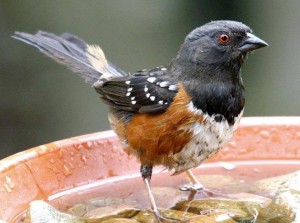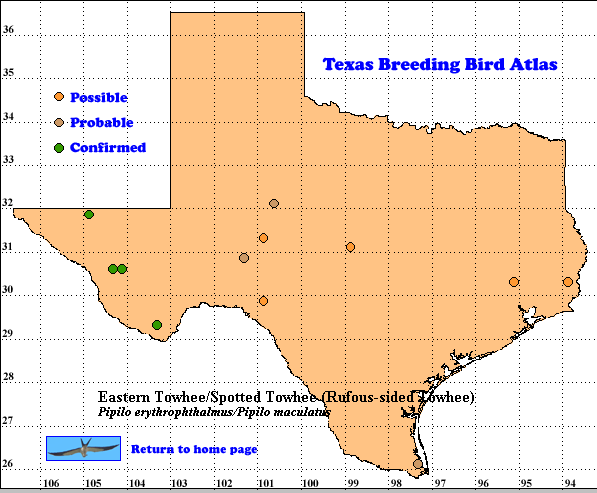The Spotted Towhee was known by this name before 1957 when it was lumped with the Red-eyed Towhee of eastern North America into the Rufous-sided Towhee, which was then split into Spotted and Eastern (P. erythrophthalmus) towhees after the completion of the TBBA fieldwork in 1987-1992. Thus two species share a TBBA map.
Spotted and Eastern towhees can be distinguished visually by the spots on the back of the western species, as well as vocally (Greenlaw 1996).
DISTRIBUTION. Lockwood and Freeman (2004) describe the breeding range of Spotted Towhee in Texas as the mountains of the Trans-Pecos region, suggesting the confirmed breeding records collected by TBBA participants in the Chisos, Davis and Guadalupe mountains represent Spotted Towhees. The 3 possible and 2 probable records from the general vicinity of the Edwards Plateau probably represent late migrant Spotted Towhees and the two possible records in extreme east Texas probably represent late migrant Eastern Towhees.
Outside Texas the Spotted Towhee breeds from British Columbia, Alberta and Saskatchewan, south on the Pacific Coast to northern Baja California. The United States distribution extends east to the western border of the Great Plains with the exception of desert areas of the intermountain west and the southwest. Spotted Towhee also breeds at the higher elevations of Mexico and Guatemala.
In winter northern migrants are found in eastern Kansas, Oklahoma and northeast Mexico as well as at lower elevations in the southwestern United States and western Mexico (Greenlaw 1996).
SEASONAL OCCURRENCE. Spotted Towhee breeds from May to early September in the mountains of Tran Pecos Texas. Winter migrants from the northern Rocky Mountains and intermountain west arrive starting in early October. They become common throughout all but the eastern third of Texas where they are rare. Winter visitors depart by early May (Oberholser 1974, Lockwood and Freeman 2004).
BREEDING HABITAT. In Texas the Spotted Towhee breeds between 1700 and 2400 m (5700 – 8000 ft) elevation in brushy areas in oak, and conifer habitats (Oberholser 1974).
The nest is placed in a depression in the ground (dug by pair) under a bush or in a bush within 1.5 m (5 ft) of the ground. The female builds the bulky nest in about 5 days. It is constructed of leaves, bark strips, plant stalks, twigs, and grasses; and lined with grasses, hair, bark shreds and pine needles. She lays 3-4 (sometimes 5) grayish or creamy white eggs (see Harrison [1979] for photo of markings), somewhat similar to the eggs of Eastern Towhee. She incubates the eggs for 12-13 days. Only the female broods the nestlings which leave the nest when 9-11 days old. A pair can raise at least 2 broods in a season. The species is a host to Brown-headed Cowbird (Molothrus ater) parasitism (Oberholser 1974, Harrison 1979, Greenlaw 1996).
STATUS. Lockwood and Freeman (2004) describe Spotted Towhee as an uncommon to locally common summer resident in the Trans-Pecos mountains of Texas.
The Breeding Bird Survey does not sample Spotted Towhee in Texas. Across the species’ range in the United States and Canada the data for this species provide a 95% confidence interval (19 times out of 20 the actual trend will fall between these two figures) of -0.3 to +1.0% population change per year for the 1966 to 2003 period (Sauer et al. 2004).
Although the status of a small breeding population is always precarious, the absence of any indication of a strong population decline across the breeding range of this species suggests the Spotted Towhee will continue to be a part of the Texas avifauna for many years, at least as a migrant and winter resident.
Text by Robert C. Tweit (2004)
Literature cited:
Greenlaw, J. S. 1996. Spotted Towhee (Pipilo maculatus). In The birds of North America, No. 263 (A. Poole and F. Gill, eds.). The Birds of North America, Inc., Philadelphia, PA.
Harrison, H. H. 1979. A field guide to western birds’ nests. Houghton Mifflin, Boston, MA.
Lockwood, M. W. and B. Freeman. 2004. The TOS handbook of Texas birds. Texas A&M University Press, College Station.
Oberholser, H. C. 1974. The bird life of Texas University of Texas Press, Austin.
Sauer, J. R., J. E. Hines, and J. Fallon. 2004. The North American Breeding Bird Survey, results and analysis 1966-2003. Version 2004.1. USGS Patuxent Wildlife Research Center, Laurel MD (Web site, http://www.mbr-pwrc.usgs.gov/bbs).

